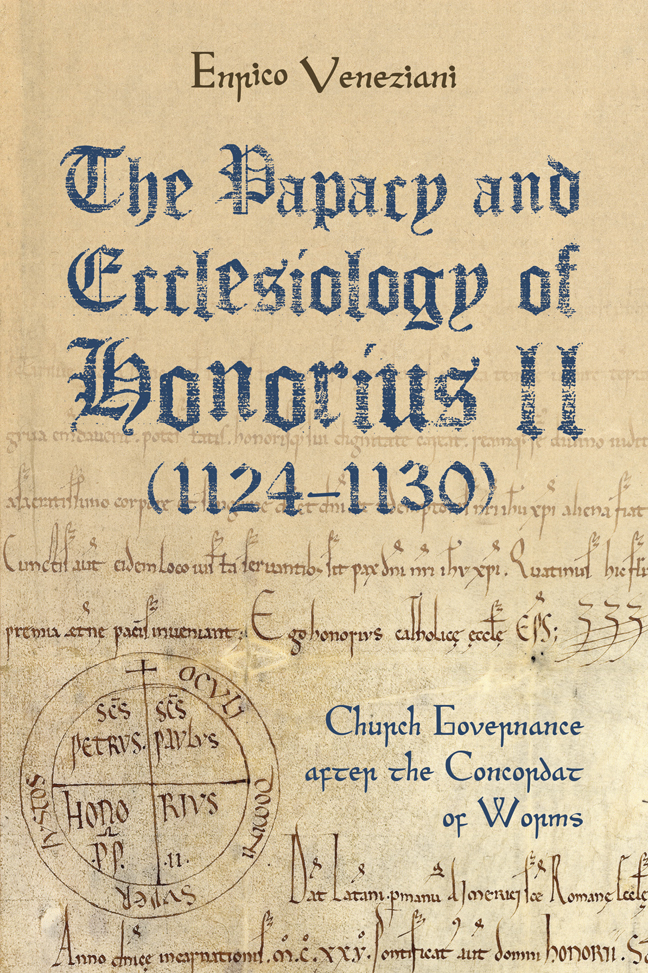 The Papacy and Ecclesiology of Honorius II (1124-1130)
The Papacy and Ecclesiology of Honorius II (1124-1130) Book contents
- Frontmatter
- Dedication
- Contents
- List of Illustrations
- Acknowledgements
- List of Abbreviations
- Introduction
- 1 Honorius II and Roman primacy: continuities and innovations
- 2 The instruments used to assert Roman primacy
- 3 Honorius's deafening silences: his relations with lay powers
- 4 Ecclesiology at work: a case study of Montecassino
- Conclusion
- Appendix: A preliminary calendar of the letters of Honorius II
- Bibliography
- Index
- Studies in the History of Medieval Religion
Introduction
Published online by Cambridge University Press: 09 January 2024
- Frontmatter
- Dedication
- Contents
- List of Illustrations
- Acknowledgements
- List of Abbreviations
- Introduction
- 1 Honorius II and Roman primacy: continuities and innovations
- 2 The instruments used to assert Roman primacy
- 3 Honorius's deafening silences: his relations with lay powers
- 4 Ecclesiology at work: a case study of Montecassino
- Conclusion
- Appendix: A preliminary calendar of the letters of Honorius II
- Bibliography
- Index
- Studies in the History of Medieval Religion
Summary
The apse of the chapel of St Nicholas in the Lateran palace was dominated by a mural – destroyed in the 1730s – which represented ‘the apotheosis of the victorious papacy’, to quote Gerhard Ladner. The chapel was built by Calixtus II (1119–1124), but the frescoes were painted – or modified, at least – during the pontificate of Anacletus II (1130–1138). The mural showed several reforming popes surrounding the Virgin. The two pontiffs kneeling at Her feet have been identified as Calixtus II and Anacletus II, but other historians have noted the significant omission of Honorius II (1124–1130) from the images. This absence has been interpreted in different ways; while Stanley Chodorow saw this as evidence that even at the time this papacy was seen as the beginning of the schism that occurred at Honorius's death in 1130 between Innocent II and Anacletus II, Mary Stroll argues that the omission shows that Honorius was not considered part of the tradition of the reforming popes.
The reason may not be clear, but the absence of Honorius II is significant, exemplifying a certain difficulty even for his contemporaries in defining his pontificate – a difficulty which persisted even after his death, as shown by the marginal mention of his tomb in the second version of Descriptio Lateranensis ecclesiae, written circa 1150s. Was he the learned but ambitious and treacherous pope that emerges from his Life in the Liber Pontificalis? Or was he the scared but devout man who, according to Falco of Benevento, during an earthquake in Benevento ran to the church and, prostrated before the altar, wept and prayed for the Lord's mercy? Or again, was he the warrior-pope addressing his supporters and exhorting them to fight Roger II of Sicily? The same issues are also found in modern scholars’ works; Stroll has defined Honorius as an ‘enigma’, while Chris Wickham more recently has spoken of a ‘colourless pope’. The historiographical image of a ‘grey pope’ fits perfectly: Honorius has always been considered a transitional pontiff. Perhaps because of the brevity of his pontificate and because it fell between such giants as Calixtus and Innocent–Anacletus, scholars have always disregarded him, focusing instead on Honorius's predecessors and successors.
A study of the ecclesiology of Honorius II's papacy addresses a period of transition for the papacy, immediately after the 1122 Concordat of Worms, which has not been fully understood by the historiography.
- Type
- Chapter
- Information
- The Papacy and Ecclesiology of Honorius II (1124-1130)Church Governance after the Concordat of Worms, pp. 1 - 24Publisher: Boydell & BrewerPrint publication year: 2023


